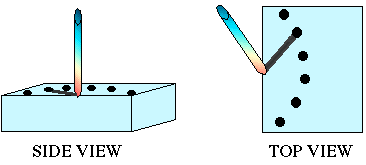

A shadow plot can also help you obtain a feel for how the Sun's path changes across the sky from day to day. To see this effect it is best to work on the shadow plot for several weeks.
![]()

Once you have found a flat location, clear from shadows, push the ball of clay onto the ground. Insert the wooden dowel into the ball of clay so that it stands vertically. The dowel will need to stand in this exact location for the entire day, or for several weeks, so make sure it is secure. You may need to wrap some duct tape around the base of the dowel and further secure it to the ground in this manner or be creative and find a way to secure the dowel so that it remains perfectly vertical.
Once your dowel is in place look for its shadow. If it is morning, the dowel's shadow should be pointing west. Lie your piece of paper down on the south side of the dowel with the middle of the long edge up against the base of the dowel support. (You can figure out which general direction is south since you know the Sun is in the east and the dowel shadow is facing west.)
The image above will help you set up your materials correctly.
Secure the piece of paper with several rocks. Place the rocks, or other
heavy objects, around the edge of the paper so they do not obscure the
middle where you will be making your plot.
You are now ready to start making your measurements.
The shadow from the dowel should be on your piece of paper. If it is not
wait about an hour and return once the shadow is cast onto the paper.
When you have the shadow on the paper, use your permanent marker to make
a mark at the very end of the shadow.
Return to your shadow plot about once every half hour and make a mark at the end of the shadow each time. If you begin your plot at 9:00 a.m. you should have enough markings by 3:00 p.m. When you are finished with one day of measurements you plot should look like the one above.
You are now ready to use this plot to find Geographic South.